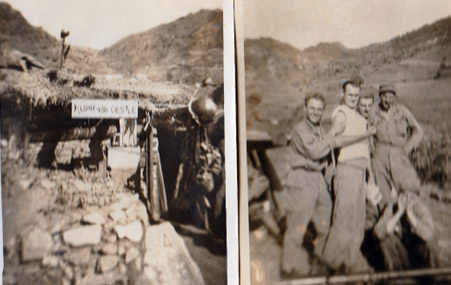A few weeks ago, I was helping take photos of veterans at a local senior living facility. As part of the project, we asked the residents to bring photos of themselves from their time in the military so we could use them alongside the current photos. I scanned the old photos into my editing program and thought about how some looked like they could have been 1950’s movie stars, handsome in their dress uniforms, a mix of serious expressions and big smiles. Although sixty-plus years had passed, I could still see the traces of the younger men and women they were in their faces.
But of all the historical photos I was given that day, the most precious was a full photo album shared by a 96-year-old Korean War veteran. He came down to pose for his photo and handed me a beautiful book with an embossed cover from Japan. He sat down next to me and showed me a few of the pages inside, telling me some of the stories behind the photographs. He told me he’d been drafted for World War II first, but it ended before he could go. A few years later, he was drafted again. The first page of his album had his Army paperwork for the Korean War.
I flipped through the book with him, looking at photos of him wearing his uniform standing next to a 1940’s sedan, posing with his family, and having a picnic together in the park. As we got further in, there was a yellowed news clipping from his hometown paper stating he was “now a member in the 27th infantry ‘wolfhound’ regiment of the 25th division. This is the army unit which has been in almost continuous action against the Communists in Korea since last July.” Surrounding this clipping were photos of young men with their arms on each other’s shoulders, goofing around and smiling in their fatigues, holding rifles in their battle gear behind piles of brush, or loading what I guessed to be rocket launchers on their shoulders.
A few more pages in, another news clipping announced he was now “a member of the orderly staff assisting United Nations delegates to the military armistice conference at advance headquarters near Munsan. His permanent station is the UN base camp.” He listed off names of the high-ranking officers he served as he pointed to their pictures. I looked at these important men who were kind enough to pose for his camera, now pieces of history loosely pasted into this book I was holding. An unnamed Chinese soldier stared back at me in another photo, with the name of a far-away place written in blue ink at the top. After that, more photos of the people who were trying to bring the Korean War to an end.
I told him I was amazed that he had these photos and that I hoped someone in his family had copied them into a permanent file somewhere. Then I asked him if it would be possible for me to borrow his album so I could scan one of his photos for the project. He was kind enough to say yes and I put it into a plastic Ziploc bag and fretted about losing it until I could safely hand it back to him at the Veterans Day event.
After the ceremony ended, I thanked him for entrusting me with the album and handed him a few prints from his photos that I enhanced from my scans. He opened the album up and looked at a couple of the pages. “They’re all gone now,” he said, the young faces smiling at us in black and white. “I’m the only one left from this group.” The words hung in the air for a few seconds as both of us thought about that. “And I think I’m the oldest veteran here today,” he said with a smile, looking at the crowd that was slowly dispersing. “I was hoping there might be a few World War II guys here still, but I guess not anymore.”
I shook his hand and watched as he headed out to grab supper in the dining room with the other residents. For all the joys of being granted a long and healthy life, the hardest part must be all the good-byes along the way.

